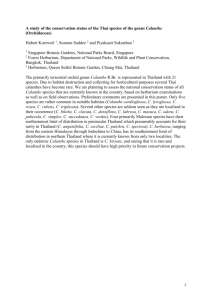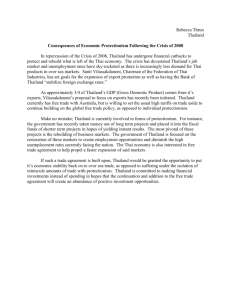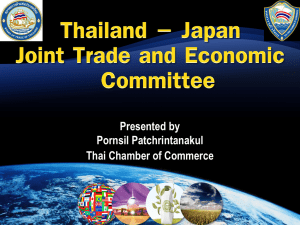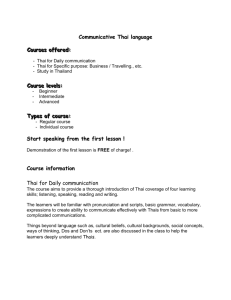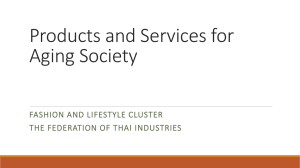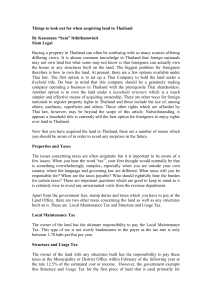Healing and the Middle Way: Doc
advertisement
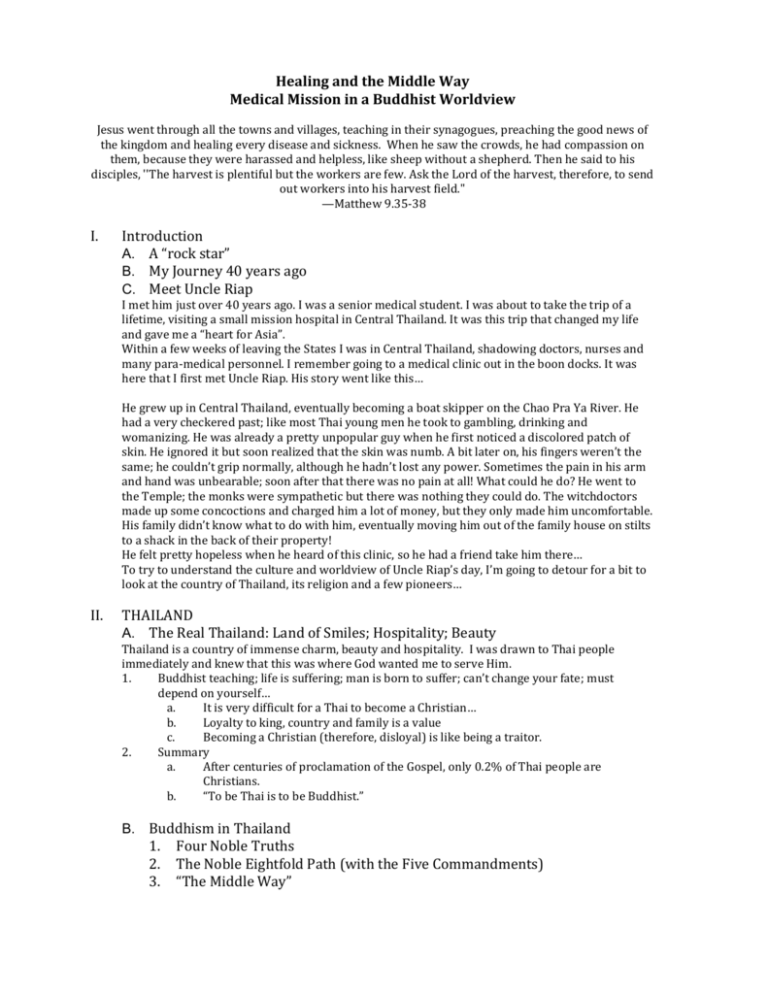
Healing and the Middle Way Medical Mission in a Buddhist Worldview Jesus went through all the towns and villages, teaching in their synagogues, preaching the good news of the kingdom and healing every disease and sickness. When he saw the crowds, he had compassion on them, because they were harassed and helpless, like sheep without a shepherd. Then he said to his disciples, ''The harvest is plentiful but the workers are few. Ask the Lord of the harvest, therefore, to send out workers into his harvest field." —Matthew 9.35-38 I. Introduction A. A “rock star” B. My Journey 40 years ago C. Meet Uncle Riap I met him just over 40 years ago. I was a senior medical student. I was about to take the trip of a lifetime, visiting a small mission hospital in Central Thailand. It was this trip that changed my life and gave me a “heart for Asia”. Within a few weeks of leaving the States I was in Central Thailand, shadowing doctors, nurses and many para-medical personnel. I remember going to a medical clinic out in the boon docks. It was here that I first met Uncle Riap. His story went like this… He grew up in Central Thailand, eventually becoming a boat skipper on the Chao Pra Ya River. He had a very checkered past; like most Thai young men he took to gambling, drinking and womanizing. He was already a pretty unpopular guy when he first noticed a discolored patch of skin. He ignored it but soon realized that the skin was numb. A bit later on, his fingers weren’t the same; he couldn’t grip normally, although he hadn’t lost any power. Sometimes the pain in his arm and hand was unbearable; soon after that there was no pain at all! What could he do? He went to the Temple; the monks were sympathetic but there was nothing they could do. The witchdoctors made up some concoctions and charged him a lot of money, but they only made him uncomfortable. His family didn’t know what to do with him, eventually moving him out of the family house on stilts to a shack in the back of their property! He felt pretty hopeless when he heard of this clinic, so he had a friend take him there… To try to understand the culture and worldview of Uncle Riap’s day, I’m going to detour for a bit to look at the country of Thailand, its religion and a few pioneers… II. THAILAND A. The Real Thailand: Land of Smiles; Hospitality; Beauty Thailand is a country of immense charm, beauty and hospitality. I was drawn to Thai people immediately and knew that this was where God wanted me to serve Him. 1. Buddhist teaching; life is suffering; man is born to suffer; can’t change your fate; must depend on yourself… a. It is very difficult for a Thai to become a Christian… b. Loyalty to king, country and family is a value c. Becoming a Christian (therefore, disloyal) is like being a traitor. 2. Summary a. After centuries of proclamation of the Gospel, only 0.2% of Thai people are Christians. b. “To be Thai is to be Buddhist.” B. Buddhism in Thailand 1. Four Noble Truths 2. The Noble Eightfold Path (with the Five Commandments) 3. “The Middle Way” 4. Syncretism on Steroids: Hinduism, Animism, Shamanism C. The Result: Fatalism Hopelessness and Despair Ancestor Worship, III. Pioneers in Medicine A. Dr. Dan Beach Bradley 1. Background 2. Contributions 3. Legacy Born in Marcellus, NY in a Christian home. His father was a pastor. Graduated from N.Y. Medical College and married Emelie Royce after a brief mail courtship, on the way to the field, Siam. Bradley arrived in Siam (Thailand) in 1835, when he was 32 years old. His professions included: evangelist, doctor, printer, writer, government advisor and an unofficial America Ambassador. His Era of service was referred to as the Bradley Era. The King of Siam, Mongkut, was a progressive man and was eager to learn about many subjects including Christianity, in order to propagate Buddhism. He loved the Thai people and made such contributions to the culture as: vaccinations, natural science, establishment of schools, hospitals, dispensaries, leper colonies, urged prison reform, education for women, care for the insane and medical procedures. He performed the first surgical operation in the country. Dr. Bradley performed the first surgical procedure, the first blood transfusion, the first dental procedure and the first vaccination against smallpox, saving perhaps tens of thousands of lives! For good measure, he also printed and published the first newspaper! It was a truly awesome experience. I felt like I was walking on holy ground. … were performed by Dr. Dan Beach Bradley, an ordinary man who wanted to make a difference in Siam. You rate his importance: The period of time that he spent in “Siam” (1835-1872) has been called the “Bradley Era”. Early 19th century missionaries have been called the second greatest influence (to the Chakri dynasty of kings) in the modernization of Thailand!! He was Royal Physician, friend and advisor to King Mongkut (Rama IV). So, who do you think had more influence in Thailand during this period of time, Maw Bradley or the legendary Anna? The Journal of the RTCS reviewed this history in its 1999 issue as well. Although after thirty years of dedicated missionary service, he could not point to one true convert, many of Bradley's contemporaries went on to China, where the convert ratio was much better. The seeds of Bradley's life full of caring and good works surely served as a seed bed for others to come and harvest. Commentary: Dr. Bradley was one of the most remarkable of a whole host of medical missionaries in the 19th century, leading Andrew F. Walls to call medical missions the “heavy artillery” of 19 th century mission effort. B. Dr. Chris Maddox 1. CIM & “Reluctant Exodus” 2. Pioneer MCH. IV. Worldview Question and Observations A. Introduction 1. Neil goes to his first RTCS conference in Bangkok During my first year in Thailand, I studied Thai language in Bangkok. I discovered that the Royal Thai College of Surgeons had an annual meeting, so I attended it. I usually walk right past the booths, drug reps and into the meeting. But something caught my eye. It was a display featuring the history of medicine in Thailand. And when you looked at all the firsts, most of them were by Dr. Dan Beach Bradley, a contemporary of Peter Parker. 2. “Firsts” in Hx of Thailand Medicine Why? 1. Why hadn’t Thailand developed its own scientific basis for medicine? 2. Why didn’t the government hospitals in Uncle Riap’s day have any medical cures for leprosy? 3. Why was Uncle Riap forced by his family to live in a shack away from family and community? C. Some Answers 1. What do you think? 2. The Victory of Reason, by Rodney Stark B. "A series of developments, in which reason won the day, gave unique shape to Western culture and institutions. And the most important of those victories occurred within Christianity. While the other world religions emphasized mystery and intuition, Christianity alone embraced reason and logic as the primary guides to religious truth. Christian faith in reason was influenced by Greek philosophy. But the more important fact is that Greek philosophy had little impact on Greek religions. Those remained typical mystery cults, in which ambiguity and logical contradictions were taken as hallmarks of sacred origins. Similar assumptions concerning the fundamental inexplicability of the gods and the intellectual superiority of introspection dominated all of the other major world religions." V. Uncle Riap: The “Rest of the Story” A. Going to the first Leprosy Clinic: what he experienced B. Going to Manorom Christian Hospital: what he learned, what he discovered C. The Gift D. The Blessing Then one day someone told him about these clinics. He wanted nothing to do with Christians but went to see if anyone could help. He ignored the talk about this new god and his son, but he was drawn to the singing and amazed at the care and compassion of the nurses. They even treated and dressed their smelly ulcers. And the way that these people treated each other was different from anything he had experienced before. The nurses who took me out to the “boon docks” were leprosy nurses and this was a leprosy clinic; and that is where I first met Uncle Riap. Many of these people had stumps instead of fingers and toes, no eyebrows and large ulcers on their feet: the ravages of nerve and skin damage from long standing leprosy. It was here that the nurses gave their patients medicine, read the Bible, shared the gospel and sang a few songs. Uncle Riap was one of these people and his deformities were already severe. They told him that he should go to the hospital, have his leprosy treated under supervision and that surgery might help some of his deformities. He concurred, went to Manorom Christian Hospital, received the treatment. He also joined the other leprosy patients. Then he noticed something different on the inside. He realized that he was a sinner, that Jesus could save his sins and give him new life and a real hope! What an amazing transformation on the inside. Regardless of his severe outer deformities, they were only “skin deep”. Like many who suffered from leprosy in the area, he became part of one of the first churches in Central Thailand, the “leprosy church”. At the same time that spiritual transformation was taking place, other changes were happening as a result of his new friends, community and the fellowship at “Grace House” at MCH! He discovered that he had a gift. He had the gift of music. In contemporary lingo, you might say that—deformed as he was—he became the “rock star” of indigenous Thai Christian music. Before his death a few years ago, he wrote nearly 40 indigenous Thai hymns and encouraged many more. Despite having only stumps for fingers, he could play many musical instruments. By the way, Uncle Riap is the successful composer and musician that I had in mind!! This hopeless leprosy outcast experienced Christ, found fellowship and hope for the future. But note that this hope was not just the hope of going to heaven. It was that but much more than that; Uncle Riap became a “living hope” for all those around him and for all Thai Christians who sang the praises that he composed! VI. Contributions of Medical Mission A. See PPT. B. Impact of MM: country people, domestic staff, employees, Thai Christian professionals. VII. Conclusion A. A real “rock star” B. Peoples resistant to the gospel respond to compassion offered in Jesus’ name. Uncle Riap’s story is just one of hundreds, no, thousands of stories of the impact of medical mission in the lives of ordinary people, who then made an impact on their community. C. “The harvest is plentiful but the workers are few…” How, where and when will you make an impact on your world? Bibliography The Contribution of Medical Missions: The Intercultural Transfer of Standards and Values, Christoffer H. Grundmann, in Academic Medicine (vol. 66, no. 12), 1991. Mo Bradley and Thailand, Donald C. Lord, Eerdmanns, 1969 More Than Skin Deep, Margaret Armitage, OMF Books, 1988 Paddy Field Hospital: The Story of Manorom, Catherine Maddox, Lutterworth Press, ca. 1960 The Rise of Christianity: How the Obscure, Marginal Jesus Movement Became the Dominant Religious Force in the Western World in a Few Centuries. Rodney Stark, Harper One, 1996 Surgery in Thailand, Jinda Suwanarak, in The Thai Journal of Surgery, Oct.- Dec., 1999 (Vol. 20, No. 4) Turbulence and Toe-holds, Stephen Hayes, OMF Publishers, 1991 The Victory of Reason: How Christianity Led to Freedom, Capitalism, and Western Success, Rodney Stark, Random House Trade Paperbacks, 2006 http://en.wikipedia.org/wiki/Buddhism_in_Thailand (last accessed 8 November 2010) http://en.wikipedia.org/wiki/Buddhism (last accessed 8 November 2010) Neil O. Thompson, MD FACS, FRTCS National Director OMF International (U.S.) 1 800 422 5330 www.omf.org/us/ nthompson@omf.org Global Missions Health Conference Louisville, KY 11-13 November 2010
